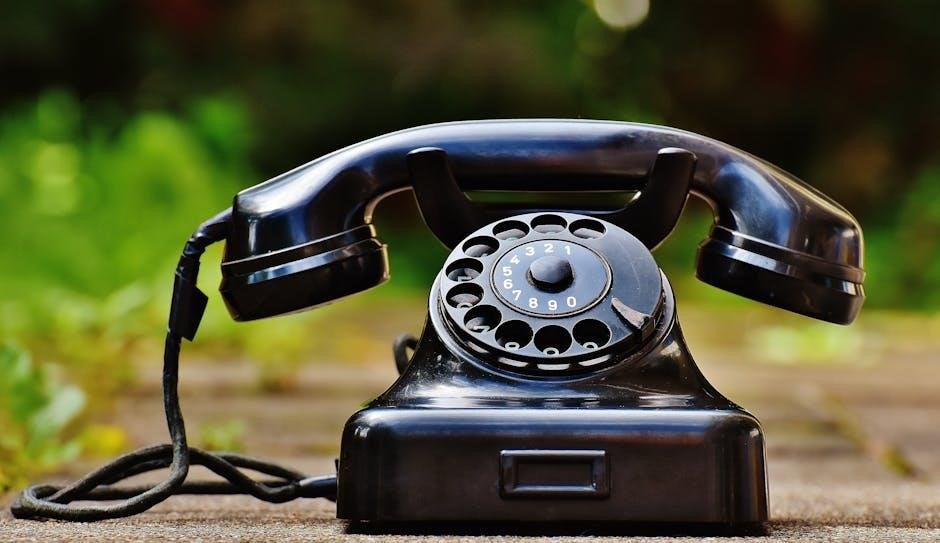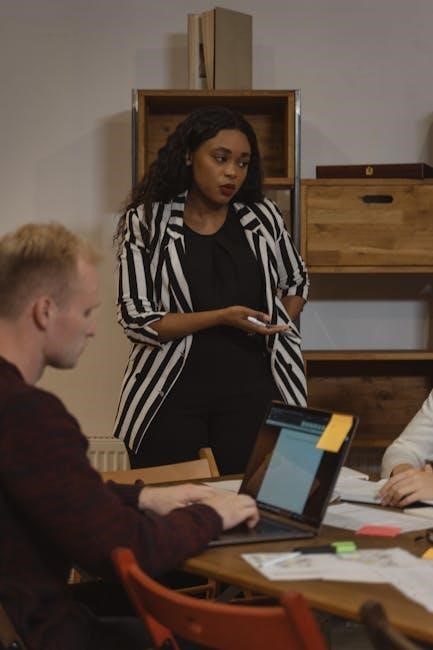Effective communication is the cornerstone of meaningful relationships, involving clarity, active listening, and empathy. How to Talk to Anyone offers practical insights to enhance these skills for impactful interactions;
Overview of the Book “How to Talk to Anyone”
How to Talk to Anyone: 92 Little Tricks for Big Success in Relationships by Leil Lowndes is a comprehensive guide to mastering communication skills. This self-help book offers practical advice on improving interpersonal interactions, covering topics such as body language, conversation starters, and active listening. With 92 actionable techniques, it equips readers to navigate various social and professional scenarios with confidence. The book emphasizes the importance of adaptability, empathy, and authenticity in building connections. Whether for personal or business relationships, How to Talk to Anyone provides tools to enhance communication effectiveness and foster meaningful relationships. Its approachable tone and real-world applications make it a valuable resource for anyone seeking to improve their people skills.
The Importance of Communication Skills in Relationships
Effective communication is vital for building and maintaining strong, meaningful relationships. It fosters understanding, trust, and emotional connection, allowing individuals to express their needs and feelings clearly. Positive communication skills, such as active listening and empathy, help resolve conflicts and strengthen bonds. In How to Talk to Anyone, Leil Lowndes emphasizes the role of adaptability and authenticity in interactions. By mastering these skills, individuals can navigate social and professional relationships with confidence, fostering deeper connections and mutual respect. Strong communication is the foundation of lasting relationships, enabling individuals to convey their thoughts and emotions effectively while understanding others.
Key Concepts Covered in the Book
How to Talk to Anyone by Leil Lowndes provides a comprehensive guide to effective communication, offering 92 practical techniques to enhance interpersonal skills. The book covers essential strategies for engaging others, including the importance of body language, active listening, and adapting communication styles. It emphasizes the value of empathy and authenticity in building connections. Readers learn how to navigate conversations with confidence, handle difficult interactions, and leave a positive impression. The book also explores advanced techniques like mirroring and positive reinforcement, making it a valuable resource for improving both personal and professional relationships. These concepts are designed to help individuals communicate more effectively and achieve their goals.

Understanding Body Language and Nonverbal Cues
Body language and nonverbal cues, like smiling and posture, play a crucial role in communication, often speaking louder than words and shaping first impressions instantly.
The Role of Body Language in First Impressions
Body language significantly influences first impressions, conveying confidence and approachability. Smiling, maintaining eye contact, and open posture instantly create a positive perception, making others more receptive to interaction. These nonverbal cues often determine how people perceive your credibility and friendliness, setting the tone for future interactions. By mastering positive body language, you can make lasting, favorable impressions that foster stronger connections. Leil Lowndes emphasizes these techniques in How to Talk to Anyone, offering practical tips to enhance nonverbal communication and ensure memorable first encounters. Effective body language is key to leaving a lasting, positive impact.
How to Use Positive Body Language
Using positive body language involves adopting open postures, maintaining steady eye contact, and smiling warmly. These cues signal confidence and friendliness, making others feel at ease. Standing tall, uncrossing your arms, and leaning slightly forward shows engagement and openness. Smiling is particularly powerful, as it conveys warmth and approachability, instantly creating a welcoming atmosphere. Leil Lowndes suggests mirroring others’ body language to build rapport, ensuring your nonverbal signals align with your message. By consciously practicing these techniques, you can project positivity and foster meaningful connections in both personal and professional settings. Positive body language is essential for effective and engaging communication;
Interpreting Nonverbal Signals in Others
Interpreting nonverbal signals is crucial for understanding others’ emotions and intentions. Eye contact, for instance, reveals interest or evasion, while posture can signal confidence or nervousness. A genuine smile reflects warmth, whereas a forced one may indicate discomfort. Observing these cues helps tailor your communication approach. Leil Lowndes emphasizes the importance of watching how others react, allowing you to adjust your message for better resonance. By paying attention to body language, you can decode unspoken feelings and respond appropriately, fostering deeper connections. This skill is vital for effective communication and building rapport in any interaction.

Mastering Conversation Starters and Icebreakers
How to Talk to Anyone provides effective techniques for initiating conversations smoothly, helping you engage others with confidence and ease in any social setting.
Effective Techniques for Starting Conversations
Starting conversations confidently is a skill that can be mastered with the right techniques. How to Talk to Anyone emphasizes the importance of making a strong first impression by taking a stand and connecting with others through shared interests. The book suggests starting slow, gaining small wins, and adapting your speaking style to match your audience’s comfort level. Techniques like maintaining eye contact and using open, approachable body language can instantly make others feel at ease. By focusing on these strategies, you can initiate meaningful conversations effortlessly, fostering connections and building rapport in both personal and professional settings.
How to Keep the Conversation Flowing
Maintaining a smooth conversation requires balance and awareness. How to Talk to Anyone suggests using the “dual track” technique, where you express yourself while closely observing your listener’s reactions. This ensures the dialogue remains engaging for both parties. Additionally, the book advises connecting your rate of speech to your audience, adjusting your pace to match their comfort level. Positive body language, such as nodding and smiling, also plays a crucial role in keeping the conversation flowing naturally. By staying attuned to these cues and adapting your approach, you can create meaningful connections and ensure the dialogue flows effortlessly, fostering deeper relationships.
Using Humor and Wit in Communication
Humor and wit are powerful tools for making conversations engaging and memorable. In How to Talk to Anyone, Leil Lowndes emphasizes the importance of using humor to break the ice and create a relaxed atmosphere. The book suggests employing “fun and witty” approaches to keep interactions light and enjoyable. Timing and authenticity are key; humor should feel natural and not forced. By incorporating playful remarks or clever observations, you can make others feel at ease and build rapport. Additionally, the book highlights how humor can diffuse tension and turn awkward moments into opportunities for connection. Mastering this skill can make you a more charismatic and memorable communicator.

Building Rapport and Connection
Building rapport involves active listening, showing genuine interest, and using empathy to create meaningful connections with others, fostering trust and understanding in relationships.
The Power of Active Listening
Active listening is a powerful tool for fostering deeper connections. It involves fully engaging with the speaker, understanding their perspective, and showing genuine interest. Techniques like maintaining eye contact, nodding, and paraphrasing can help ensure the speaker feels heard. By focusing on the conversation and avoiding distractions, active listening builds trust and strengthens relationships. It also helps in understanding nuances, emotions, and underlying messages. This approach not only enhances communication but also makes the speaker feel valued and respected. Incorporating active listening into daily interactions can significantly improve personal and professional relationships, as emphasized in How to Talk to Anyone.
How to Show Genuine Interest in Others
Showing genuine interest in others is a cornerstone of effective communication. It involves being present, engaged, and curious about their thoughts and experiences. Techniques like asking open-ended questions, nodding, and maintaining eye contact can demonstrate your attentiveness. Expressing genuine curiosity by asking for their opinions or sharing personal experiences can deepen connections. Avoid distractions, like your phone, to fully focus on the conversation. By showing sincere interest, you create a safe and supportive environment, fostering trust and mutual understanding. This approach, as highlighted in How to Talk to Anyone, helps build strong, meaningful relationships and makes others feel valued and appreciated.
Using Empathy to Strengthen Relationships
Empathy is a powerful tool for strengthening relationships, allowing you to understand and share the feelings of others. By actively listening and showing compassion, you create a supportive environment where others feel heard and valued. Techniques like mirroring emotions and acknowledging their experiences can deepen connections. Empathy helps bridge gaps, fostering trust and mutual understanding. In How to Talk to Anyone, Leil Lowndes emphasizes the importance of aligning your responses with the other person’s emotions, ensuring they feel understood. This approach not only enhances communication but also builds lasting bonds, making relationships more meaningful and fulfilling over time.

Advanced Communication Techniques
Advanced techniques involve mirroring, strategic listening, and positive reinforcement to refine communication. These methods, explored in How to Talk to Anyone, enhance connection and understanding deeply.

The Art of Mirroring in Conversations
Mirroring is a powerful technique in communication, where you subtly reflect the other person’s words, tone, or body language to create rapport. How to Talk to Anyone highlights this method as a way to build trust and connection. By mirroring, you show understanding and empathy, making the conversation feel natural and engaging. For example, using similar phrases or nodding in sync with the speaker can deepen their sense of being heard. This technique, often referred to as “Hans Horse Sense,” encourages active listening and helps keep the dialogue flowing smoothly, fostering a sense of mutual respect and understanding in any interaction.
How to Handle Difficult Conversations
Handling difficult conversations requires a combination of emotional intelligence and strategic communication. How to Talk to Anyone emphasizes staying calm and focused, even when discussions become tense. Active listening is crucial—acknowledge the other person’s feelings and perspectives to diffuse tension. Avoid taking things personally and aim for solutions rather than arguments. Techniques like “Hans Horse Sense” encourage observing reactions and adjusting your approach accordingly. Using positive reinforcement and maintaining a respectful tone can turn potentially explosive situations into productive exchanges. By mastering these strategies, you can navigate challenging conversations with confidence and achieve mutually beneficial outcomes, fostering stronger relationships in the process.
Using Positive Reinforcement in Communication
Positive reinforcement is a powerful tool in communication, fostering a supportive and encouraging environment. How to Talk to Anyone highlights techniques like acknowledging others’ contributions and showing genuine interest. By using verbal cues such as praise or agreement, you can make others feel valued and heard. Non-verbal signals, like nodding or smiling, also reinforce positive interactions. This approach helps build trust and rapport, making conversations more productive and enjoyable. Regular use of positive reinforcement can transform difficult dialogues into collaborative exchanges, ensuring both parties feel respected and understood. It’s a simple yet effective way to strengthen connections and enhance communication outcomes.

Overcoming Communication Challenges
Mastering communication challenges involves adapting your style to different audiences and situations, ensuring clarity and understanding. Techniques from How to Talk to Anyone help navigate tough conversations effectively, fostering connection and mutual respect.
Dealing with Shyness and Social Anxiety
Overcoming shyness and social anxiety requires gradual confidence-building and strategic techniques. How to Talk to Anyone suggests starting with small interactions and using positive body language to ease discomfort.
Practicing active listening and focusing on others’ needs can shift attention away from personal nervousness. The book emphasizes the importance of patience and persistence in transforming shy individuals into confident communicators.

How to Recover from Communication Mistakes
Recovering from communication mistakes involves acknowledging the error, apologizing sincerely, and moving forward. How to Talk to Anyone suggests that owning up to mistakes demonstrates maturity and honesty, which can strengthen trust.

It’s important to learn from the misstep and adapt your approach to prevent repetition. By focusing on solutions rather than dwelling on the error, you can redirect the conversation positively and maintain a smooth interaction. This resilience is key to effective communication and building lasting connections.
Adapting Your Communication Style to Different Audiences
Adapting your communication style to different audiences ensures your message resonates effectively. How to Talk to Anyone emphasizes the importance of tailoring your approach to match the listener’s needs and preferences.
By observing their reactions and adjusting your tone, pace, and content, you can create a more engaging and meaningful connection. This flexibility fosters understanding and builds rapport across diverse groups, allowing you to communicate with confidence and clarity.
How to Talk to Anyone equips readers with practical tools to enhance communication. By mastering these techniques, individuals can foster stronger relationships and achieve personal and professional growth.

Summarizing Key Takeaways from the Book
How to Talk to Anyone provides 92 practical techniques to improve communication skills. Readers gain insights into active listening, body language, and conversation starters. The book emphasizes the importance of empathy and adaptability in building rapport. Techniques like mirroring and positive reinforcement are highlighted as effective tools. The author, Leil Lowndes, offers actionable advice to overcome shyness and handle difficult conversations. By applying these strategies, individuals can enhance their interpersonal skills, leading to more fulfilling personal and professional relationships. The book serves as a comprehensive guide for anyone seeking to become a more confident and effective communicator.
Practical Steps to Improve Communication Skills
Mastering effective communication involves several practical steps. Start by practicing active listening, focusing on the speaker’s words and nonverbal cues. Use positive body language, such as maintaining eye contact and smiling, to create a welcoming atmosphere. Develop conversation starters and icebreakers to engage others effortlessly. Learn to adapt your communication style to your audience, ensuring clarity and relatability. Incorporate humor and wit to make interactions enjoyable. Employ techniques like mirroring to build rapport and show genuine interest in others. Finally, embrace empathy and positive reinforcement to strengthen relationships. Consistent practice of these strategies will enhance your communication skills and foster deeper connections.
The Long-Term Benefits of Effective Communication
Effective communication fosters deeper connections, strengthens relationships, and enhances personal and professional growth. By mastering the skills outlined in How to Talk to Anyone, individuals can build trust, resolve conflicts more efficiently, and convey their ideas with clarity. Improved communication leads to stronger professional networks, increased empathy, and a greater ability to navigate diverse social situations. Over time, these skills contribute to personal satisfaction, as meaningful interactions become more frequent and fulfilling. Ultimately, effective communication is a lifelong asset that enriches all aspects of life, from intimate relationships to career advancement, ensuring long-term success and happiness.
